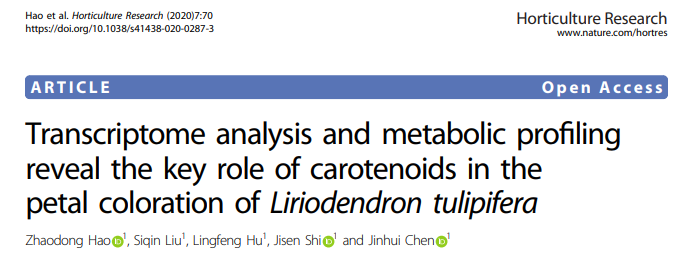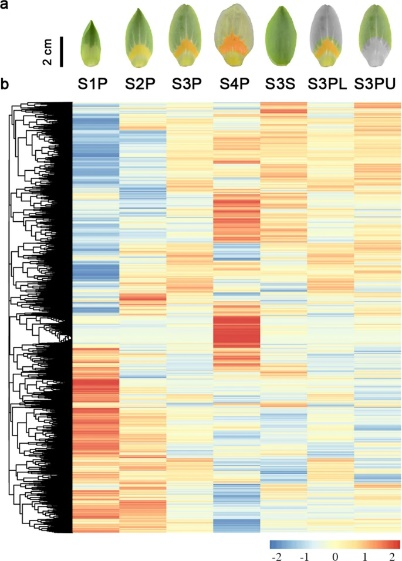Why do the flowers of North American tulip trees have a bright orange band? Transcriptomics and metabolomics joint analysis reveals the answer for you
The beautiful flower in the picture is the flower of the North American tulip tree. As seen in the image, there is a bright orange band near the base of the petals. Why does the flower of the North American tulip tree have a bright orange band? Transcriptomics and metabolomics joint analysis reveals the mystery for you!

s3
Beautiful flowers not only provide us with visual enjoyment but also use their petal colors as a primary floral feature to attract pollinators, ensuring successful reproduction. The diversity of flower colors is mainly composed of three major pigments: flavonoids, carotenoids, and betalains. The precise spatial and temporal regulation of the gene expression related to the synthesis of these pigments results in specific coloration patterns.
The North American tulip tree (Liriodendron tulipifera) has a bright orange band near the base of its petals, but the development, regulation, and biochemical basis of this petal band coloration remain unclear. This article combines transcriptomics and metabolomics of the tulip tree species to identify the main pigments contributing to the formation of the orange band on the petals and defines possible transcriptional regulatory mechanisms.

s3-2
Journal: Horticulture Research
Impact Factor: 5.404
Publication Date: May 2020
Article Link: https://www.nature.com/articles/s41438-020-0287-3#Sec1
Abstract
The North American tulip tree (Liriodendron tulipifera) is a popular ornamental horticultural plant with a distinctive orange band near the base of its tulip-shaped flower. The mechanism of petal band-specific pigment deposition during the development of the tulip tree flower remains unclear. Researchers used multi-omics joint analysis, integrating untargeted and targeted metabolomics with transcriptomics, to identify the cascade pathway of carotenoid biosynthesis specifically activated in the petal band. Comparative analysis of carotenoid metabolites between the North American tulip tree and its hybrid species indicates that γ-carotene, a rare carotene in plants, is the most likely orange pigment responsible for the petal band coloration. Phenotypic and transcriptome analysis of developing petals showed that the band region is initially predetermined by the loss of green, and then maintained by the localized activation and inhibition of carotenoid and chlorophyll biosynthesis genes, respectively. Two rate-limiting genes of carotenoid biosynthesis, carotenoid isomerase (CRTISO) and ε-lycopene cyclase (ε-LCY), encode the core enzymes responsible for orange pigment deposition in the specific petal band. Compared to the Chinese tulip tree, the North American tulip tree has an additional ε-LCY copy, which the authors hypothesize may contribute to the unique petal coloration pattern. In summary, this study provides the first insights into the metabolomic and transcriptomic dynamics of tulip tree flower coloration and offers valuable resources for floral breeding or metabolic engineering, as well as understanding the floral evolution of early woody angiosperms.
Main Results
Researchers collected petals at four different developmental stages of the North American tulip tree flower for transcriptomic and metabolomic analysis. A total of 4,799 metabolites were obtained in the time-course data set of untargeted metabolomics, showing significant differences (p <0.05) between at least two stages. Clustering and KEGG enrichment analysis revealed that carotenoids might play a key role in the petal coloration of the North American tulip tree. Transcriptome sequencing yielded 224,245 unigenes, with functional annotation for 63.22% (141,781) of the genes. Clustering analysis of genes with significant changes in unigene expression across all samples showed stage/organ-specific transcriptomic features during tulip tree flower development. Transcriptomic data analysis suggests that localized transcriptional regulation of gene expression in the petals of the North American tulip tree may lead to carotenoid biosynthesis and accumulation, resulting in petal band coloration during flower development. Targeted metabolomics further confirmed the role of carotenoids in the petal band coloration of the North American tulip tree: localized accumulation of γ-carotene at specific sites may be the key process leading to petal band coloration during the flowering of the North American tulip tree. Kinetic analysis of key carotenoid enzymes showed that the detected ε-LCY gene is upregulated on the lower side of the petals compared to the sepals and upper side of the petals.

Transcriptomic Analysis of Petal Development in the North American Tulip Tree

Genes Involved in Petal Coloration in the Development of the North American Tulip Tree

Content of Four Carotenoids in the Petals of Tulip Tree Hybrids
Biotech company BGI provides multi-omics integrated analysis services, including joint analysis of transcriptomics and metabolomics.
Teachers interested are welcome to contact us!
Related Services
Integration of Transcriptomics and Metabolomics Analysis
Multi-omics Integrated Analysis
Transcriptome Sequencing
Metabolomics
How to order?





